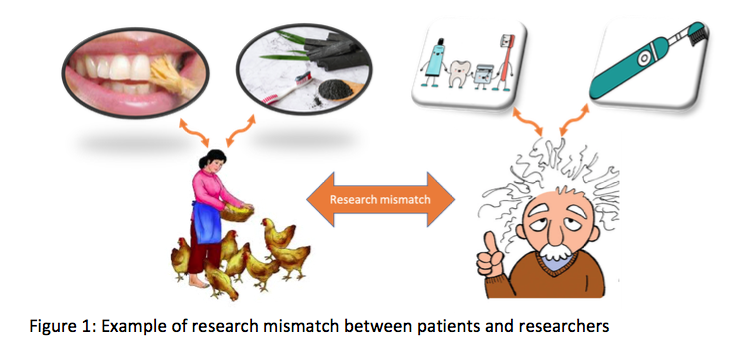Research priority setting
Posted on 17th April 2020 by Sumanth Kumbargere Nagraj

What is research priority setting?
Research priority setting (RPS) can be described as an interpersonal activity to decide the key questions or research topics which are agreed to be the priority. This could be predominantly driven by stakeholders, analysis of data, or a combination of both. The RPS can be a smaller exercise, focused on a disease area or the scope of a specific group and organisation (e.g. research priorities of Cochrane Oral Health group), or it can be broad and inform strategies on a larger scale such as at country level (e.g. research priorities of Malaysia for the year 2020).
There is no clear agreement on the definition of RPS – some only focus on the identification and ranking of topics (a-c) and others would say that the process needs to go beyond finding the priorities (beyond step c to level g). One example to categorise the steps in a priority setting exercise is:
a. Identification of stakeholders
b. Identifying research topics or questions
c. Ranking the topics or questions (example: top 10 or top 20 research questions)
d. Dissemination of the results to all stakeholders
e. Provision for appeal
f. Implementation of the priorities
g. Evaluation of the process and outcome
What is the purpose of RPS?
The purpose of RPS depends on the scope, objectives and goals of the organisation that commissions or runs the RPS exercise. It might inform the strategic allocation of resources (which can be financial or non-financial, such as staff time) or used as an advocacy tool to promote change in the priorities of other organisations or groups. Stakeholder engagement often plays a key role in this process. The selection of who is involved at which stage of the exercise drives whose opinion and values define the final priorities. For example, James Lind Alliance focuses specifically on the priorities of patients and clinicians. The choice of individuals involved in the priority setting exercise is particularly important as we have evidence of a clear mismatch between different stakeholder’s, specifically patients with clinicians and researchers in certain topic areas as shown in Figure 1.

A well-conducted RPS exercise can contribute in reducing research waste. This is more critical in countries or organisations that have limited resources to maximise the usage of resources in tackling the needs of the community and address the imbalances in the health research system.
Which organisations provide methods guidance on setting priorities for research?
There are several research groups that provide this guidance. Some examples are the James Lind Alliance, Council on Health Research For development (COHRED) and Cochrane Priority Setting Methods Group.
Are there different approaches to identify research priorities?
Yes, there are different ways to categorise priority setting exercises. There are known approaches to set priorities for research that cover all the steps of the exercise e.g. James Lind Alliance approach or Child Health and Nutrition Research Initiative (CHNRI). However, this only works if organisations agree with all the values and guidance in those approaches. There are different methods that can be used for different stages of a priority setting exercise e.g. using interview or survey for identifying questions or Delphi or nominal group for reaching consensus on ranking. Organisations can decide how to adapt each step based on their scope, aims, values and resources. There are some broad categories that priority setting exercises are sometimes categorised to: technical assessment which is dominated by epidemiological and cost data, and interpretive assessment dominated by consensus of stakeholders/ participants. However, priority setting exercises can be a combination of these two approaches.
Are there any current challenges associated with designing and implementing a RPS process?
Based on our knowledge, in a lot of organisations, research priority setting exercises are not documented, evaluated or published and we do not currently know the extent of unpublished information in this field. There has been an increase in methods studies in this field, however, there are still lots of unanswered questions. For example, how do we evaluate the success of outcome of a priority setting exercise? How do we ensure that we choose and include the right stakeholders to represent the different groups affected by the results? What is the best approach to engage with them especially if there are major disagreements between stakeholder groups? How can we deal with issues or topics that cannot easily be translated into an answerable research question?
In response to these challenges, the James Lind Alliance have developed the “Reporting guideline for PRIority SEtting of health research (REPRISE)“.



